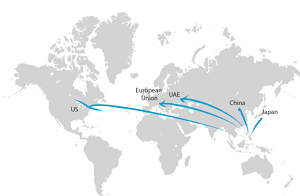Philippines
Find support in this market.
Ease of trading across borders
Importing a standard container of goods into Philippines requires:
Introduction
The Philippines is one of the fastest growing economies in the world with a GDP growth of 6.3% in Q4 2015 and a remarkably positive GDP growth trajectory over a decade, which is projected to increase 8.8% by 2018. It is the second largest market in ASEAN with 103 million people. The main engines of growth are services sectors (e.g. real estate, manufacturing and tourism) and the substantial forex earnings from Filipino expats amounting to US$26b annually.
Economic snapshot (% annual growth rate)
| 2014 | 2015 | 2016-19 | |
|---|---|---|---|
| GDP | 6.1 | 5.8 | 5.6 |
| Export of goods and services | 11.3 | 5.5 | 6.5 |
| Import of goods and services | 8.7 | 11.9 | 6.7 |
| Inflation | 4.2 | 1.4 | 3.2 |
| Exchange rate (per $) | 44.4 | 45.5 | 45.9 |
| Population | 1.6 | 1.6 | 1.5 |
| Source: Oxford Economics |
Economic outlook
Despite the typhoon in November, the Philippines’ economy expanded by 1.5% in Q4 2013 on the back of surprisingly resilient private consumption. Net exports also contributed significantly, with exports much stronger than imports at the end of the year. The Philippines is anticipated to be one of the best performing economies in the Asia-Pacific region in 2014, second only to China, growing 6.3% in 2014, reflecting continuing strong growth in private consumption and the external sector contributing positively to growth. In addition, reconstruction after the typhoon is likely to lift government expenditure.
Trade outlook
Since 1980s, the Philippines have opened their economy to foreign markets, and established a network of free trade agreements with several countries. The US is one of the Philippines top trading partner. The Philippines largely imports electronic products, mineral fuels, machinery and transport equipment, iron and steel, textile fabrics, grains, chemicals, plastic. The largest importers into the Philippines include Japan, China, Singapore, South Korea, Taiwan and Thailand.
Cultural tips
- Filipinos are highly personalised and relational - Face-to-face business transactions are encouraged
- Traffic tends to be heavy especially during peak hours
- Corruption is pervasive in the government sector
Essential Customs Tips
The de minimis value is USD 20 for shipments into Manila (MNL), while the de minimis value into Cebu (CEB) is USD 10.
Philippine Customs require Importers to be accredited by the Customs AMO (Account Management Office) or clearance will not be allowed. Full commodity descriptions must be provided on the waybill and commercial invoices must be on company letterheads for non document shipments to private individuals.
SWOT analysis
| Strengths Successful reforms in the financial and public sectors. |
Weaknesses Poor Infrastructure. Corruption. |
| Opportunities Fastest Growing Economy in Asia. Top destination for services, specifically IT business process outsourcing sector. |
Threats Shortages of skills. |
Philippines's trade with the UK
Sector segmentation growth
Sectors to watch:
- sector
- sector
Manufacturing
- manufacturing
- manufacturing
Fastest-growing exporters into Philippines
| Rank | 2012 |
|---|---|
| 1 | Chile |
| 2 | Morocco |
| 3 | Poland |
| 4 | China |
| 5 | Brazil |
| 6 | Cambodia |
| 7 | India |
| 8 | Kenya |
| 9 | Turkey |
| 10 | South Korea |
Total merchandise trade - Leading import partners

Opportunities for UK businesses
Strategically located in Southeast Asia, the Philippines is an ideal market for doing business particularly for companies that are looking to set up a regional operation. A huge opportunity lies with the infrastructure and construction sector as the government takes forward projects through public-private partnerships (PPP).
Find support in this market.
Your local Chamber provides a range of export services and links to overseas markets.
Find your local Chamber here.


